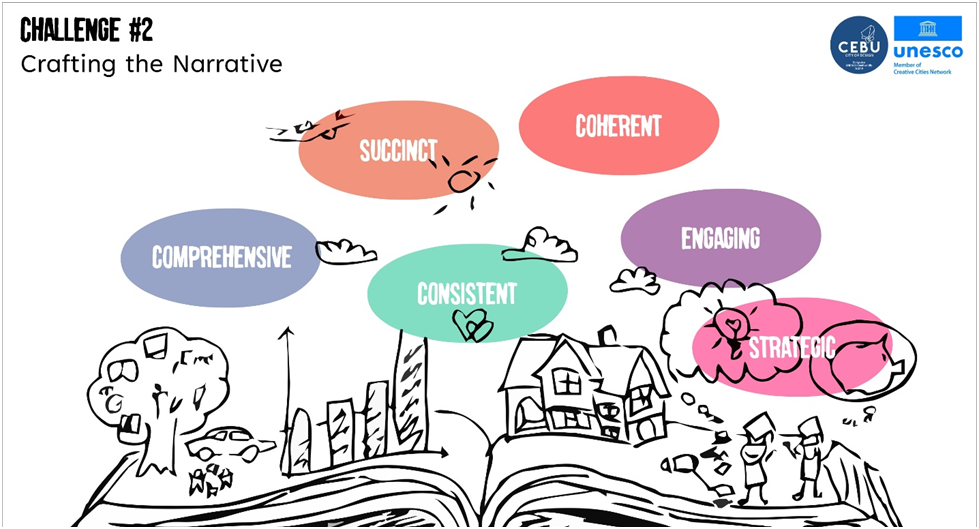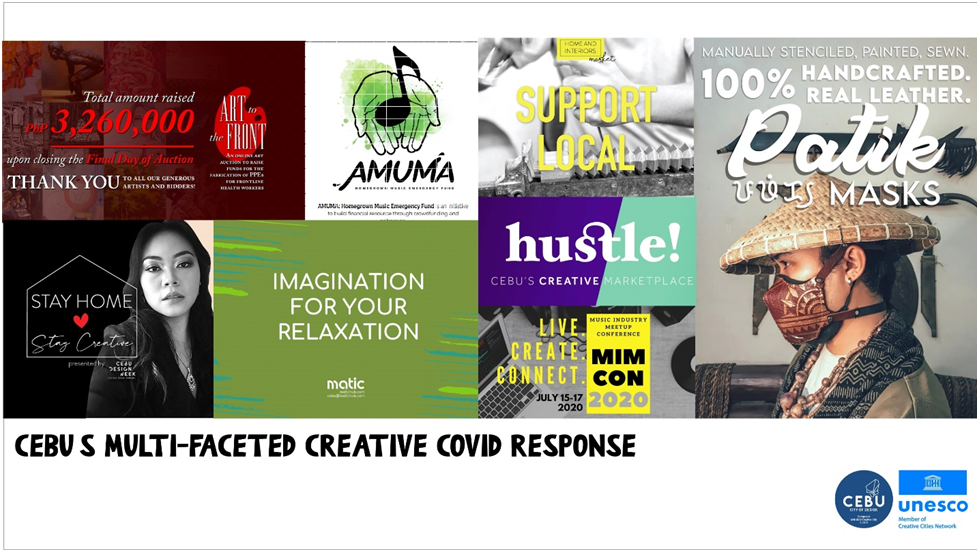
Posted by DESIGN Cebu Admin
November 15, 2021
THE JOURNEY
Cebu’s UCCN designation did not happen overnight and was an in fact the result of an 11-year progression which “officially” started in 2008 when the city was chosen as the Philippine’s hub for creative industries by the British Council.

Since that initial designation, Cebu attained more accolades from being designated the ASEAN City of Culture for 2011-12 and hosting the Southeast Asian Creative Cities Network Conference in 2015. In 2017, the traditional creative industries of Fashion, Furniture and Home Furnishings banded together for Chambers – The Cebu Project which then led to Cebu Design Week (CDDW) in 2018.

REASONS FOR APPLYING
The 2019 application was a natural progression from the momentum sparked by CDW in 2018 which was launched to connect, create &cultivate the numerous but disparate creative disciplines in the city. It was hoped that a Creative City of Design designation would further galvanize the exciting movement & undoubtedly have a profound impact for Cebu:
In the short term, the designation was meant to rally the community, enhance the status of design practitioners, spur the exchange of knowledge, inspire the next generation, drive incremental tourism & reassert Cebu as the country’s leading design destination.
In the medium term, it was hoped to ignite fresh collaborations & realize big ticket projects that are designed to be force multipliers for Cebu’s collective creative output which will contribute to the city’s inclusive & sustainable development.
This designation will also enhance Cebu’s global reputation & allow for greater cross-border cooperation to help realize even bigger endeavours &affect greater positive impact in the longer term.
APPLICATION PROCESS
The Creative Cebu bid team was comprised of a variety of individuals from both the private and public sectors representing the local government unit, regional and national government agencies, business organizations, professional associations, the academe, creative hubs and design practitioners.
Meetings were initiated long before the guidelines were released and efforts intensified once criteria for evaluation became available. Subsequently, a Creative Mapathon was conducted as were discussions with prospective stakeholders & partners to elicit their support for key action items.

CHALLENGES DURING THE BID PROCESS
The biggest challenge in putting the bid together was quantifying the financial impact of the creative sector in Cebu because we all know that quality data in this country is very few and far in between. While we scoured a variety of sources and databases from DTI, SEC, the LGU, PEZA, and industry value chains, we still had to do a bit of extrapolation. However the numbers are consistent with global guesstimates because even at an international level the data still has many gaps.

The next challenge was crafting the narrative because the application is strictly character limited and has questions that, at the outset, may seem repetitive. Content management is therefore extremely important as is a lead author. Otherwise, the application may end up being a jumbled, incoherent mess.

The last obstacle was how to visually represent the diverse disciplines in the city because the application limits the number to 3. We took a risk and decided to collage them according to architecture, furniture and lifestyle so we could showcase a better portrayal of the city’s creative output.

ANNOUNCEMENT OF THE DESIGNATION
Fast forward a few months, to the early morning of Oct 31, 2019 when we were woken up with the great news that Cebu had been designated to join the 39 other cities of design and was now one of the 312 UNESCO Creative Cities worldwide.

The announcement was quite timely as a few of us involved in the bid left on a DTI/UN study tour the day after. Coincidentally, we visited Singapore and Bandung, Indonesia both of which are also UNESCO Cities of Design. It was great to meet design movement luminaries and see the difference in approaches of each city. It was also in Bandung that we first became acquainted with the Indonesia Creative Cities Network which became one of the inspirations for the PCCN.

Upon our return and doing the necessary rounds of celebrations, we quickly got to work. During the city’s 83rd Charter Day Celebration in February 2020, we mounted our first joint exhibit with the fashion, visual arts, furniture and graphic design groups. We also assisted in the branding and livery of the Cebu Integrated Bus Service which launched in March 2020 and reflected the UNESCO designation on its side panels. Around that same time, we were about to sign a MOA with SM Malls to locate NEWD or the Cebu NEWseum of Design in some unoccupied cabanas in the Sky Park of SM Seaside Cebu.

A week before the first round of COVID19 lockdowns, the British Council together with the UK’s Plymouth College of Art held the Making Futures Conference in Cebu which brought participants from over 20 countries to discuss how crafting communities can reinvent their roles in the context of global challenges.

COVID 19
Little did we know during the Making Conference that perhaps the greatest global challenge to confront this generation was just about to explode in all of our collective faces. COVID19 definitely put an abrupt stop to the breakneck speed at which we had been operating at since the designation 5 months prior. In retrospect, it was a probably a good thing since it forced us to take a breather, reassess and pivot. As mentioned in the video, we took advantage of the time while on lockdown, to gather and refine data. We also ended up strengthening our networks in ways that were not possible pre-COVID and learned new skills not just to cope with the situation but also to prepare for the eventual recovery phase.

Despite being amongst the most impacted sectors, Cebu’s creatives really stepped up to the plate and launched a barrage of COVID response efforts reflective of the diverse nature of the city’s creative landscape.

Cebu Design Week 2020 pivoted into a virtual 3 day event that gathered design experts from all over the world that would not have been possible pre-COVID.

The Blue Mango Awards launched new categories to recognize creativity while on lockdown, acknowledge that it can be manifested anywhere and in many ways and reward those who integrated design in the way they live, work and play.

A consultancy agreement with the UN’s Department of Social and Economic generated a series of reports that comprehensively assessed pandemic impacts on Cebu’s creative sector as a whole as well as the different sub-sectors that comprise it.

Part of the UN DESA initiative was the introduction of a Business Recovery Toolkit for Creative MSMEs that simplified business frameworks to assist them in their post-COVID reboot.

NOW WHAT?
With the specter of COVID still looming in the horizon and recovery timelines unclear, the role of the creative industries in post-pandemic recovery is now – more than ever – even more crucial.

Upon extensive review, our original bid components from 2019 are still valid but specific strategies had to be tweaked. Utilizing the existing talent, tech, tolerance and tenacity of Cebu’s creatives, we aim to evolve the city’s creative infrastructure and energize the Creative Cebu Grid. Components of these two aggregated initiatives are designed to increase tourism, investments and the production of creative goods and services for the local, national and international markets. Ultimately, they are intended to have positive and sustainable impacts on the economic, social and environmental dimensions.

With resources severely constrained, we’ve had to prioritize higher impact, lower effort projects based on pre-defined metrics such as revenue potential, maximum reach and least amount of funds required. So in this matrix, we are prioritizing 1s and 2s in the near term and will start on 3s sometime next year.

For its 4th iteration, Cebu Design Week returns with an in-person event with the main feature being the first Visayas Art Fair at Montebello Villa Hotel. A multi-sensoral outdoor experience set in the hotel’s extensive grounds will also provide a sensitive complement to the indoor galleries.

A hybrid design summit is also being planned to fully energize the Creative Cebu Grid and bring together local government, national government agencies, the academe and the private sector so that needs are assessed and plans to bridge gaps and align initiatives can be made.

It is also during this summit that we plan on introducing the Cebu creative community to the Philippine Creative Industries Development Bill and the PCCN as well as launch the Thames ICE Creative Cities Playbook.

During the summit, the Design Cebu Gateway, will also be launched. This online portal is meant to be a virtual converging point, marketplace, networking tool, resource database and enabling mechanism not just for Cebu-based creatives but for anyone interested in being part of the community.

These initiatives are just some examples of how we want to help dispel the fake news that Creativity is merely about non-essential aesthetics when in fact, creativity is not just essential but critical in the long term.

So by respecting the past, celebrating the present and inspiring the future, we endeavor to energize and enable Cebu’s creative practicioners – in collaboration with creative stakeholders from around the country and the world – to help build a wholistically sustainable city that excites and a Cebu that delights that is not just liveable but also loveable.

Should you wish to know more about our story or in some way collaborate on our journey, please feel free to drop us a line at hello@designcebu.comm or visit the UNESCO UCCN page at https://en.unesco.org/creative-cities/home.
